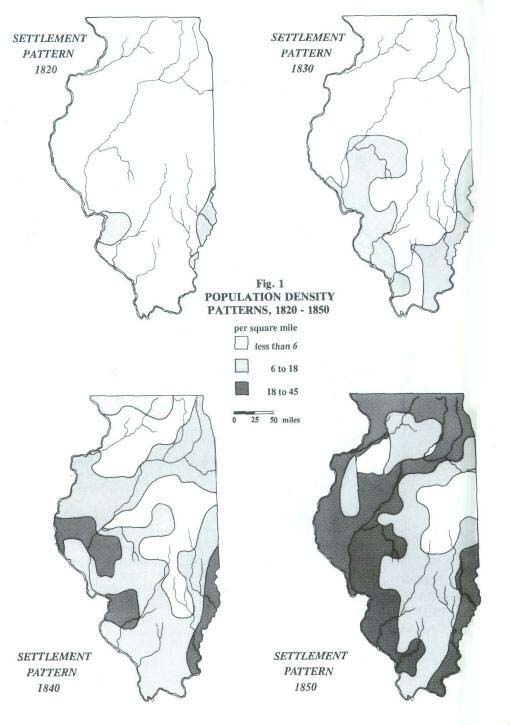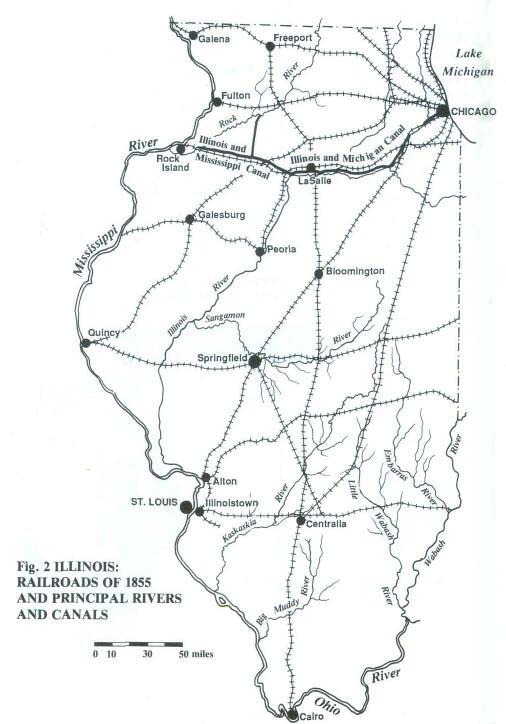|
|
MOVEMENT:
A TEACHING STRATEGY
|
Overview
Main Ideas
The background information in the previous pages and the following student activities point the way toward additional items
that the teacher and class can research and
use as a basis for class discussions. We
hope that teachers and students will take
the ideas presented here and creatively
expand on the movement theme. Use
maps, texts, periodicals, and local resource
people and organizations to enhance your
study of movement in Illinois. Local museums, colleges, historical societies, newspapers, and senior citizen groups can be valuable resources for adding a local dimension
to your research. The activity pages have
been designed to complement the text
material. The information and activities presented here lend themselves to individual
assignments, group activities, or cooperative learning projects. The teacher may wish
to add to or delete some of the learning
materials to suit local conditions, to accommodate individual teaching or learning
styles, and to tie in with current events
when appropriate.
Connection with the Curriculum
The materials in this section are
designed primarily to fit into U.S. history
and geography courses, but they could be
used in other areas of the social sciences.
These materials could also be used in a
cooperative teaching project by the social
science teacher and/or language arts or
math teachers.
Teaching Level
These materials should be usable in
grades seven through twelve; however,
capable students in grades five and six
might profit from some of the text and
activity material.
29
Materials for Each Student
Each student should have a copy of the
text material, the activity pages, outline
maps of Illinois in addition to pencil and
paper. Graph paper would be helpful.
The student will need to have access to
an atlas, a dictionary, an encyclopedia,
books on Illinois and the local community (if
available), and books on Illinois history and
geography. Back issues of Illinois History
magazine would be useful.
Objectives for Each Student
• To acquaint the student with the
concept of movement in the study
of history and geography
• To make the student aware of how
movement has affected his state,
his/her community, family, and therefore his life
• To emphasize how movement has
affected our cultural and ethnic
diversity
• To show how the theme of movement
is reflected in our state and local
community
|
SUGGESTIONS FOR
TEACHING THE LESSON
|
Opening the Lesson
To open the lesson on "movement" it
might be helpful to examine modern-day
movement. A quick survey of students
about their family movements in recent
years might provide some insights into this
concept. A discussion of immigration to the
United States in recent history could also be
a useful departure point. When the concept
of movement is understood, you should be
ready to start the text and activities.
Developing the Lesson
This lesson can be used with each student being responsible for all text and activity materials, or the various tasks can be
assigned to groups in a cooperative learning
project. In either case plans should be
made to discuss the material with the entire
class. For most classes each activity represents one class session of work. The
teacher can adjust this if necessary.
Concluding the Lesson
The concluding discussion is a good
time to develop additional critical thinking
skills. Students should be asked to list conclusions that can be drawn from the materials that they have examined and developed
in the activities. These conclusions can be
listed on the board or on the overhead, and
the validity of each conclusion can be discussed by the class.
Extending the Lesson
- Visit an appropriate museum or
library with materials on related
topics.
- Bring guests into the classroom who
might have expertise in the areas of
local history, genealogy, community
ethnic groups, etc.
- Assign a paper or project on a topic
related to themes explored in the text
and activities.
- Allow students to explore more about
their own families' role in the theme
of movement by encouraging more
research and interviews on family
history.
Assessing Student Learning
Other than traditional testing, the class
may visually show the achievement of these
objectives by preparing a bulletin board or
table-top display to demonstrate these concepts. This display could include student
research, maps, charts, art work, and borrowed artifacts. Parents and other classes
could visit the display.
30
31
32

Use an outline map of Illinois to locate the following places important to our study of
movement. You will peed to consult reference maps of Illinois.
NATURAL FEATURES: Lake Michigan, Mississippi River, Ohio Rivir, Wabash River,
Illinois River, Kaskaskia River, Rock River, Fox River
HUMAN CONSTRUCTED FEATURES: Illinois-Michigan Canal, Illinois-Mississippi Canal
the National Road, major railroads
SELECTED EARLY SETTLEMENTS IN ILLINOIS: Alton, Beardstown, Cahokia, Cfltcago,
Joliet, Kaskaskia, Lockport, Pekin, Peoria, Quincy, Rock Island, Shawneetown, Springfield,
Vandalia
Answer the following questions:
- Many early settlements established by the French, English, and Americans
had been the locations of Native American villages. What reasons can you
think of for why this is true?
- What site and situation factors do you think helped determine the locations
that people selected for these early settlements? What considerations
might be different today?
- Natural waterways were used for moving people and goods in Illinois. How
did people increase their movement options when natural waterways did
not meet their needs?
- List as many "push" and "pull" reasons as you can about why people came
to live in your local area originally and why they would come today. How
many of these reasons are related to the movement of people and goods?
33

PEOPLE, PLACES, AND TERMS TO KNOW: Native American,
settler, immigrant, customs, culture, French and Indian War, Virginia (state), Revolutionary
War, Ordinance of 1787, Black Hawk War (please refer to Figure 1 in the text).
- Native Americans were the sole occupants of the Illinois area from about 12,000 B.C.
until the 1600s. List some of the cultural gifts (place names, customs, etc.) from the
Native American that are still with us in Illinois.
- Most of Illinois' early white settlement occurred in the southern part of the state. Most
early settlers came particularly from the states of Kentucky, Tennessee, and Virginia.
Can you explain why this took place and what influence this had on the development
of Illinois?
- Interview some of the people in your family to find out when and how members of
your family came to Illinois. Briefly report on your findings.
- On a piece of paper list as many ethnic groups as you can that are a part of your
personal heritage. You do not need to put your name on this paper. The teacher will
supervise the tabulation of the frequency of the appearance of each ethnic group.
The members of your class will then be asked to construct a bar graph based on this
information. Do the results of this survey reflect the make-up of the community?
Explain.
34

PEOPLE, PLACES, AND TERMS TO KNOW: Prairie, origin, diffusion, Conestoga Wagon, flatboat, canals, cultural diversity, ethnic group, assimilation, place
names (please refer to Figure 2 in the text).

|
- People may move from place to place, but they don't leave everything behind and
start a whole new way of life. They bring some possessions and traditions with
them—tools, household goods, food preparation, politics, and religion, for example.
Choose several different culture groups, people from other areas of the U.S., or
people from foreign countries that have migrated to Illinois since 1600. Complete the
following chart for each group selected.
GROUP DATE OF ARRIVAL CONTRIBUTIONS TO CULTURE NAME OF LEADER (IF APPLICABLE)
- Since early American immigration into Illinois was from the South, what possessions
and ideas would you expect those settlers to bring with them? Explain.
- In 1825 the Erie Canal was opened across New York state. Also, steamboats came
into increasing use on the Great Lakes following the 1830s. What effect would you
expect those developments to have on the movement of people, goods, and ideas
into northern Illinois?
- How would the two migration routes above, plus the National Road, contribute to
cultural diversity in Illinois? Explain.
- Notice the place names on the map of Illinois. There are Native American, foreign,
local and national hero, classical, and descriptive names. Can you find examples of
each on the Illinois map?
35

PEOPLE, PLACES, AND TERMS TO KNOW: Highway Bond
Issue of 1918 and 1924, referendum, motor fuel tax, Great Depression, New Deal,
Interstate Highway System.
- Why would cities and towns compete so strongly to have railroads, highways, and
airports serve their communities?
- How might increased highway and airport construction between 1920 and 1960 influence the movement of people, goods, and ideas in Illinois during that period? How
would citizens pay for this type of construction?
- Explain what is meant by the statement, "Modern transportation has made the world
smaller." What implications does this have for Illinois in today's world?
- Examine the following table and answer the questions that follow.
|
YEAR
|
PASSENGER CARS
IN ILLINOIS
|
STATE, COUNTY & CITY
ROAD MILEAGE
CONSTRUCTED
|
|
1915
|
180,832
|
100
|
|
1920
|
503,762
|
366
|
|
1925
|
1,101,943
|
906
|
|
1930
|
1,429,146
|
1,081
|
|
1935
|
1,342,904
|
1,000
|
|
1945
|
1,508,222
|
557
|
|
1955
|
2,858,869
|
1,541
|
a. What events would account for the slowdown of auto ownership between 1930 and
1945?
b. What would account for the increase in road construction from 1915 to 1925? The
increase in the 1930s?
c. What generalizations can you make about the data presented in the chart?
d. How do you benefit from road construction?
Click Here to return to the Article
36
|



